What really is ‘New Fire’ Fuel?
By ignoring the often touted notion that Low Energy Nuclear Reactions (LENR) is impossible and taking the view that it is both a natural and ubiquitous process, let’s let evidence guide us.
This presentation makes extensive used of the net positive stable nuclear reaction data established by Dr. Alexander Parkhomov and made into searchable tables by Philip Power and Denis Lamotte.
Earth’s crust atomic abundance
Ever wondered why elements have the abundance they do in the earths crust?
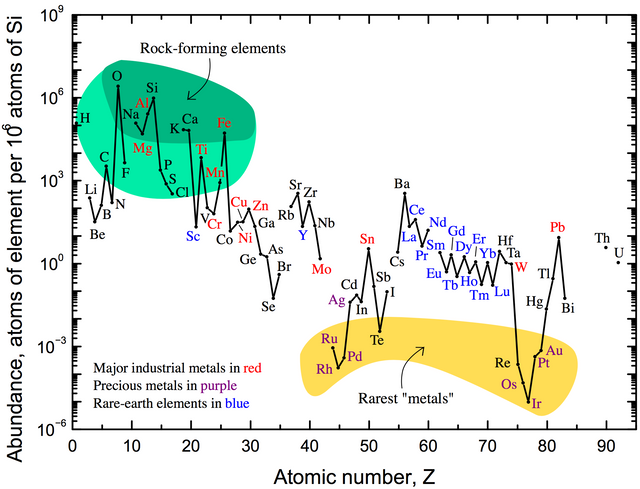
George Ohsawa reactions
Perhaps George Ohsawa reactions can give us a clue?
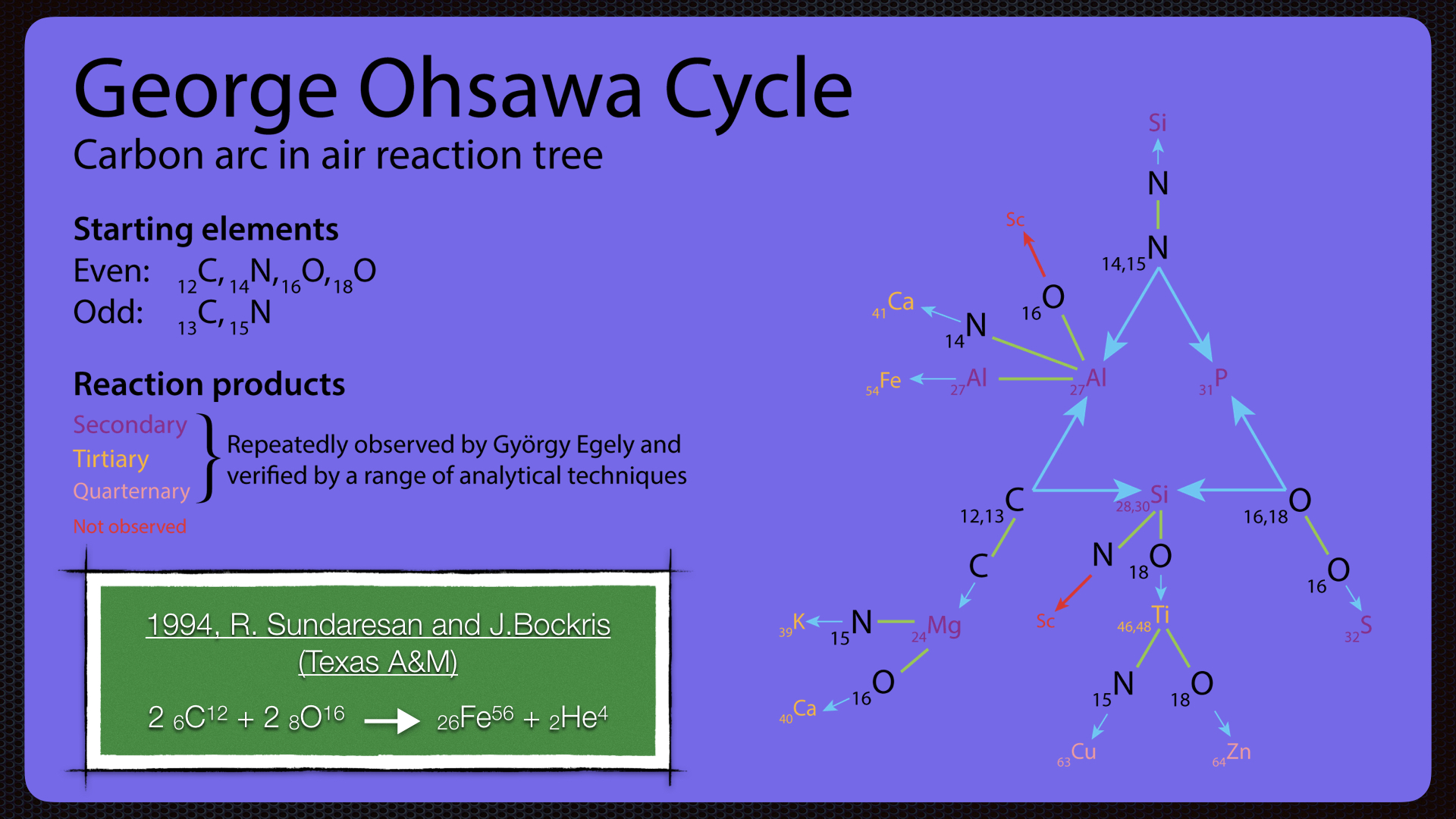
| Reaction | MeV |
|---|---|
| C + N > Al | 17.3006 to 23.3442 |
| N + O > P | 19.8036 to 26.6528 |
| C + O > Si | 16.7557 to 26.759 |
| C + C > Mg | 13.9305 to 22.4648 |
| Al + Al > Fe | 21.8426 |
| Al + N > Ca | 21.4383 |
| Al + O > Sc* | 23.0787 |
| N + N > Si | 24.6427 to 27.5322 |
| O + O > S | 16.5396 to 28.3202 |
| Si + O > Ti | 14.944 to 23.2622 |
| Si + N > Sc* | 16.7203 |
| Mg + N > K | 19.4347 to 23.6301 |
| Mg + O > Ca | 16.181 to 24.5411 |
| Ti + Si > Cu | 15.9397 to 20.0402 |
| Ti + O > Zn | 12.7214 to 21.0965 |
So the reactions observed in NOVA testing have net energy releases according to Dr. Alexander Parkhomov’s data of between 12.7214 and 28.3202 MeV.
*Not observed by Dr. George Egely, perhaps because it has quite high atomic volume and there are energetically favourable reactions of Sc with O > Cu, with N > Ni, with H or D > Ti. Also if first F is produced by combining H/D with O then this fusing with Sc produces Zn.
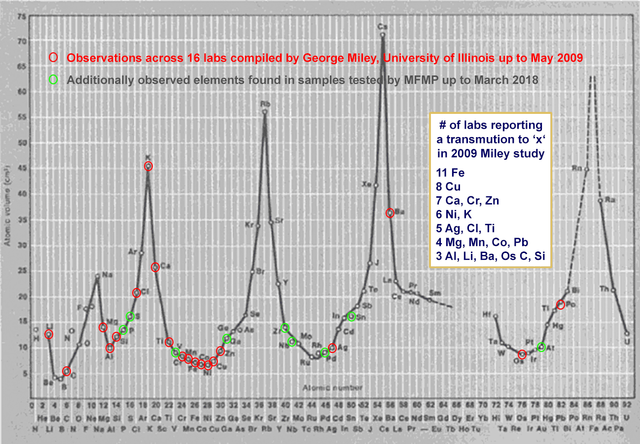
In addition, there are some net positive nucleon exchange reactions between George Ohsawa reaction products, just looking at the 2º ones for example:
| Reaction | MeV |
|---|---|
| Al + Si > H/D + Fe | 4.0082 - 11.68 |
| Si + P > H/D + Ni | 0.7545 - 8.3052 |
| Al + P > the elements He, Fe, Si, C, Ti, Mg, S, O, Ne and Ar | 0.122 - 12.1784 |
With the most energetic of the Al + P reactions producing 4He and 54Fe, both elements with low distortion of the physical vacuum according to Stoyan Sarg.
Explaining ECCO fuel
Fuel processing
The processing of fuel is discussed here.
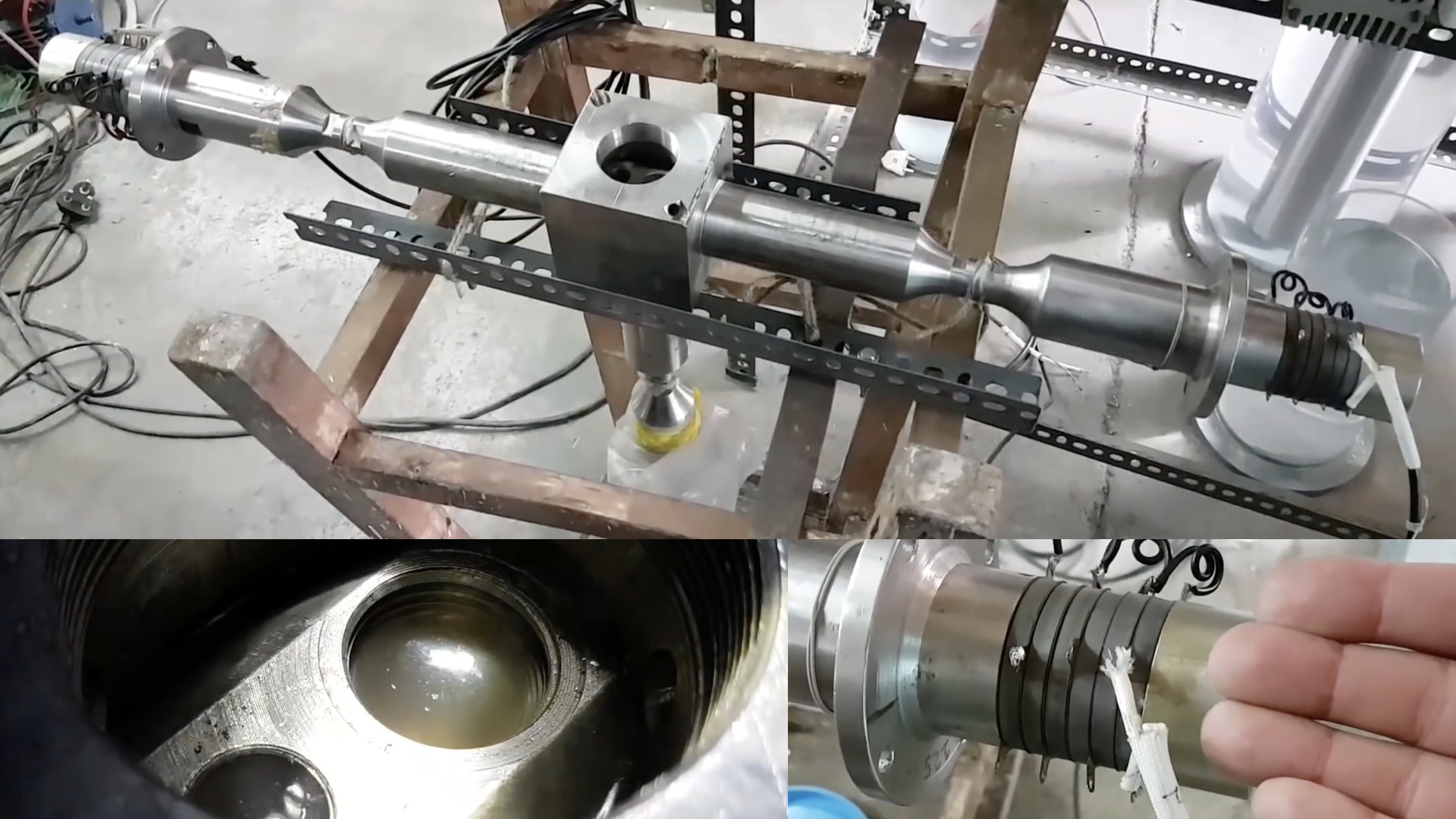
Analysis of part processed fuel showed large quantities of Pb, Zr and Nb, not meant to be in starting materials
Processed ECCO fuel had a lot of Pb, Zr, Nb in it as well as indications of Sn in addition to the H2O, Ti, C, Ni that were used. It was said by the inventor, Suhas Ralkar, that Tungsten (W) was added as a milling agent, however only some samples showed potential traces of W.
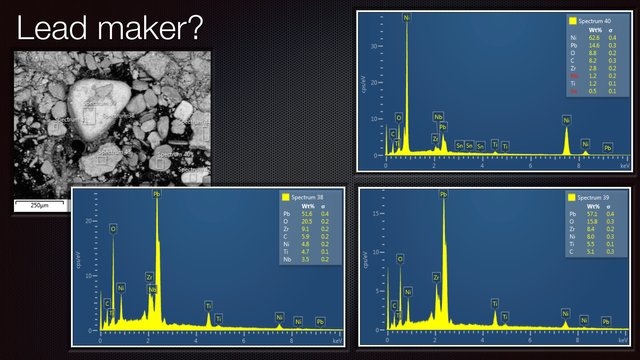

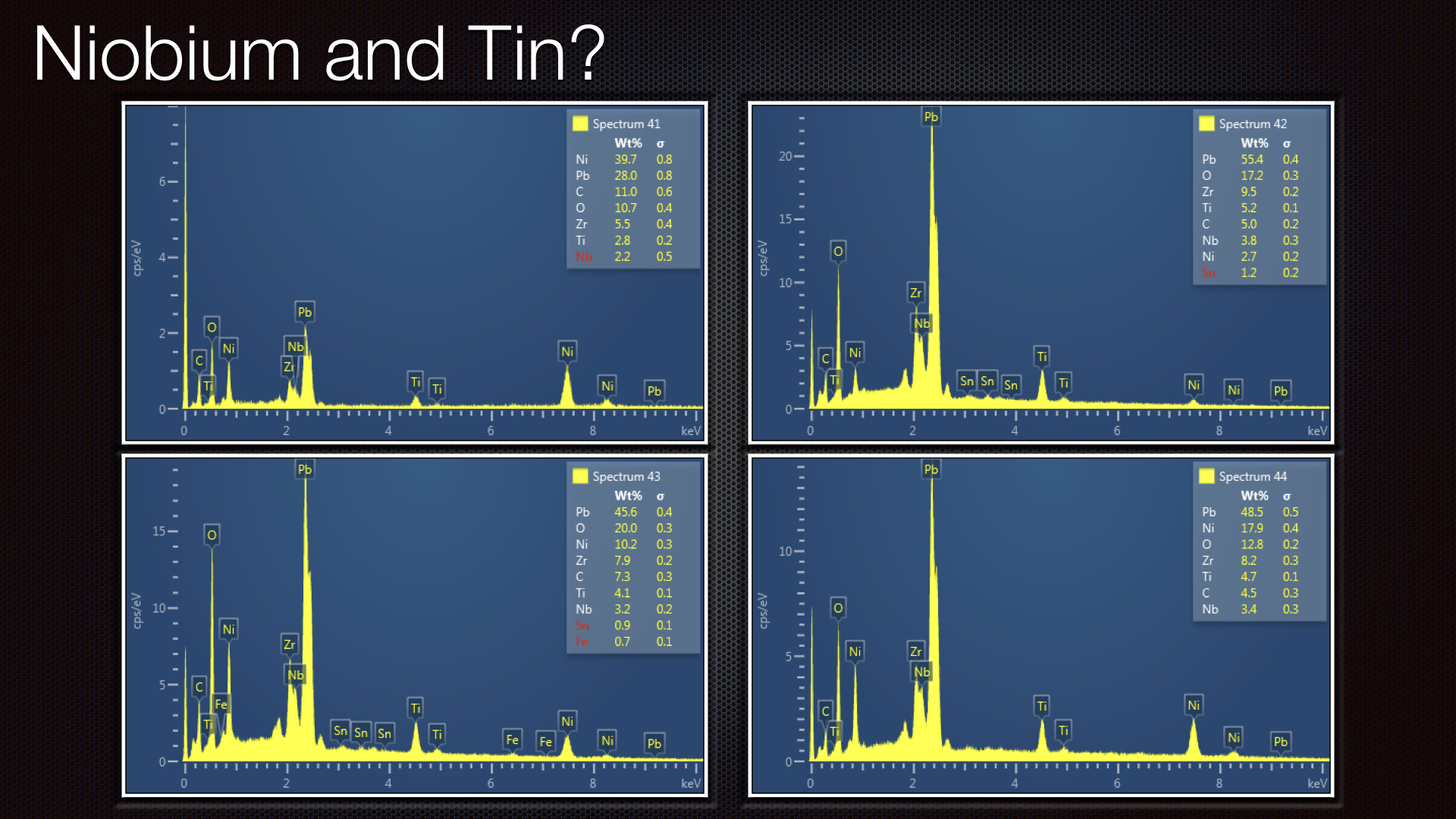
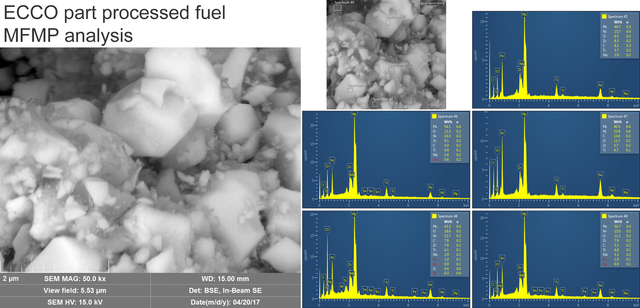
Strange radiation was observed emanating from ECCO fuel by various methods
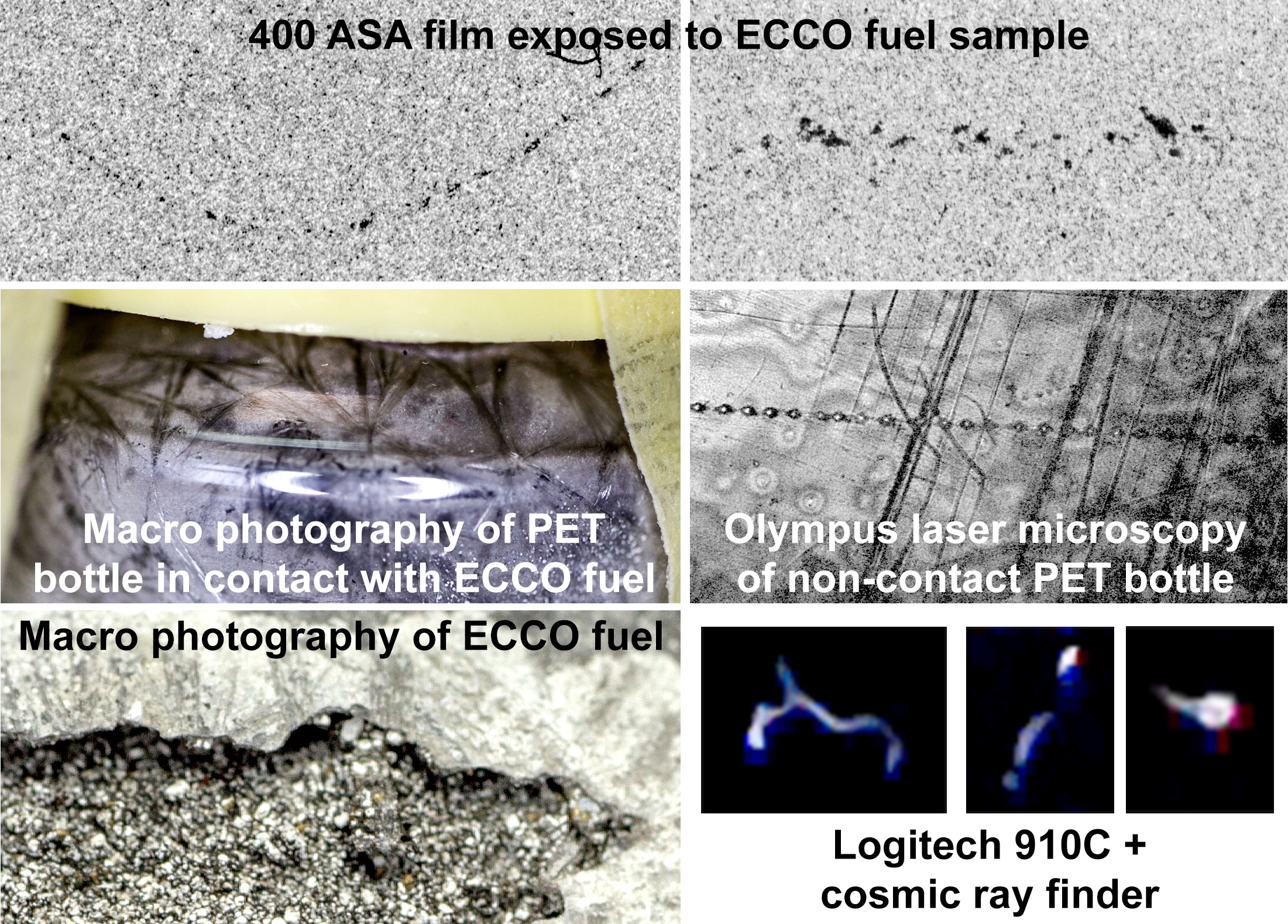
Other researchers that observed similar large scale synthesis of Pb
LeClaire / Nanospire, USA
Possibly similar to the ECCO fuel processor in that in both cases there was cavitation in water - Initial element combination were not the same however. LeClaire observed all elements including radioactive ones and in this authors opinion, this was because the active agent was driven very hard (leading to high mass isotopes) and destroyed, resulting in production of radioactive isotopes.
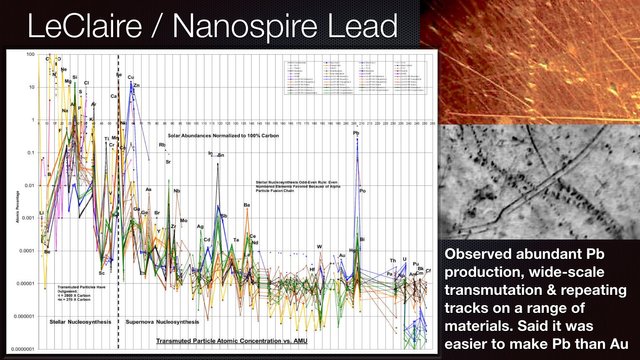
Mark LeClaire said in an interview on smart scarecrow show that it was easier to make
lead than to make gold.
S. V. Adamenko / Proton 21 Lab, Ukraine
This was an intense electrical discharge into a rounded end shaped fine anode of a pure metal.
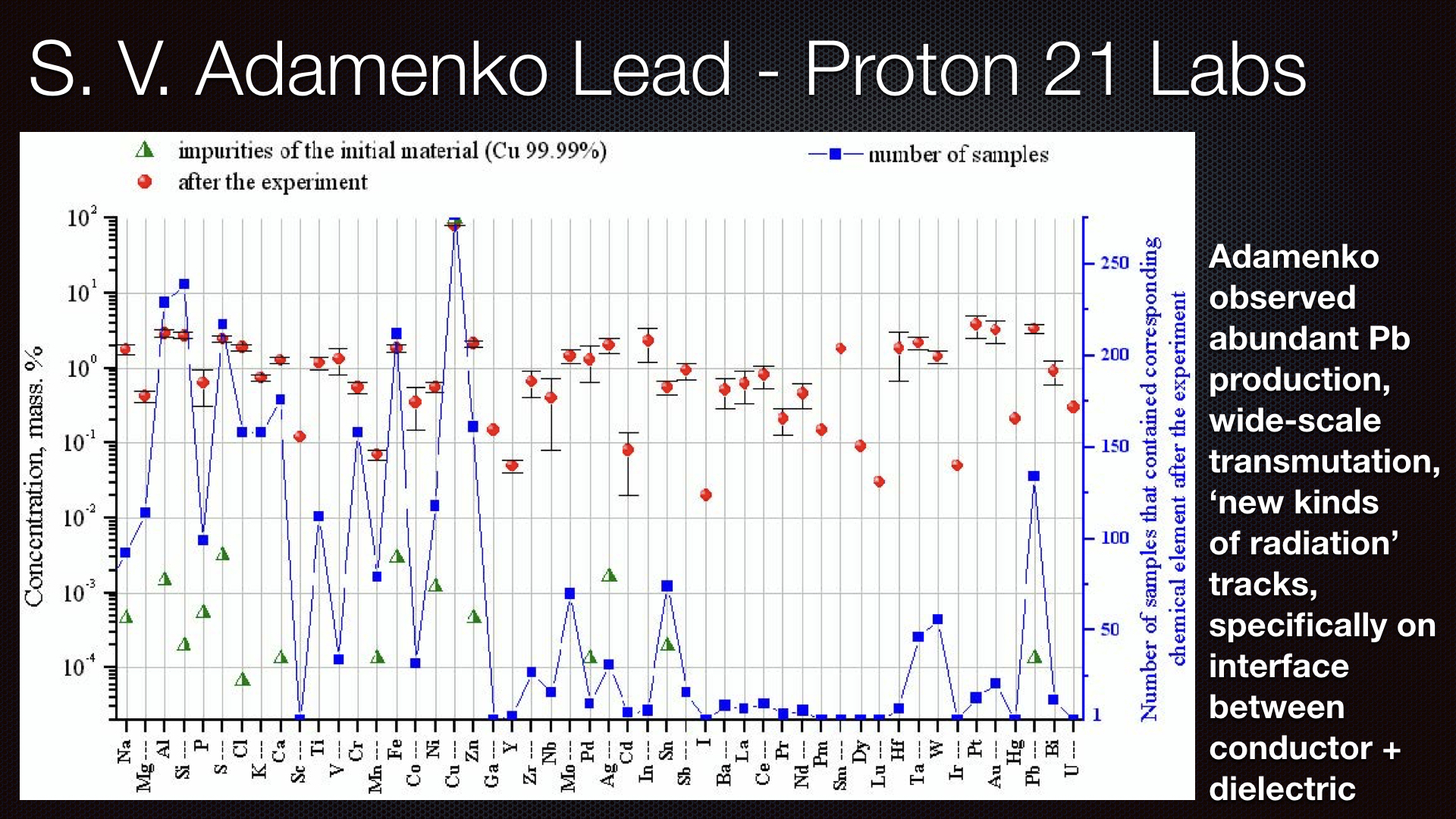
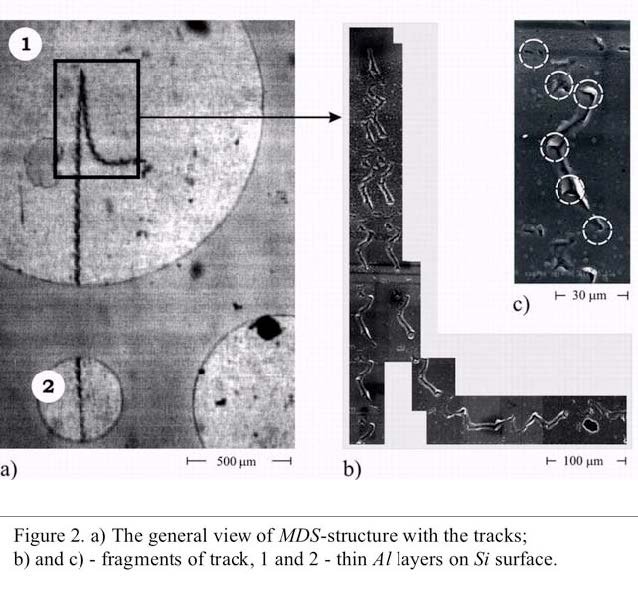
Adamenko used a "metal-dielectric-semiconductor" detector in the overall setup they developed as shown below.
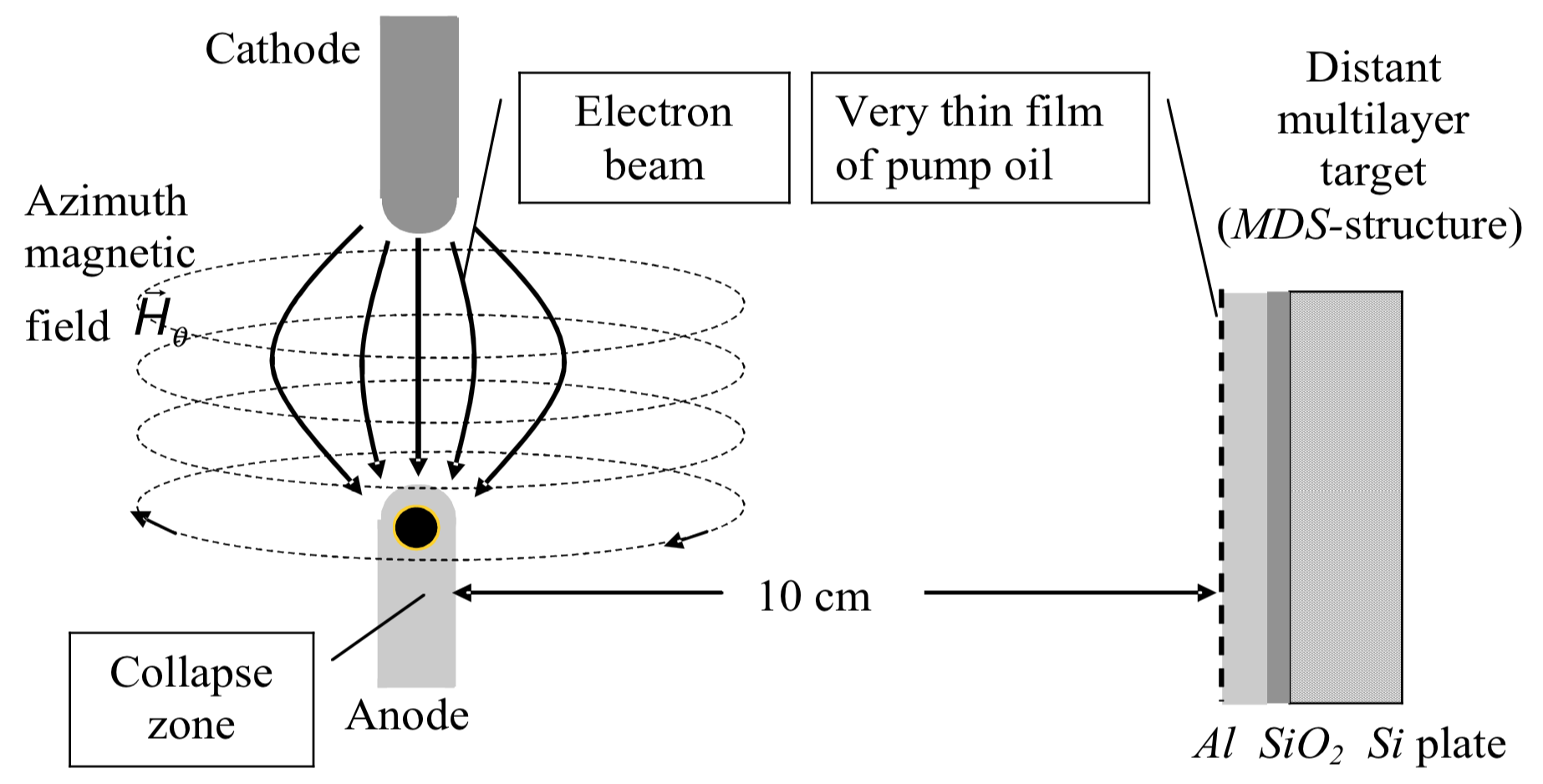
The detector so designed is interesting, because it has the very good conductor Aluminium on the surface (4th best), often shown to be the most easily effected by John Hutchison. With it’s Metal / Dielectric / semiconductor structure, it also has impedance changes, which, according to shoulders observations, exotic vacuum objects (EVOs) do not like to pass through. Additionally the thin film of oil provides ready C and H.
The mystery of missing Tungsten (W)
When the MFMP first reported the elemental composition of part processed ECCO fuel ascertained by Masaryk University SEM operators to Suhas Ralkar, there was shock and disbelief. The high concentrations of Pb, Zr and Nb especially and traces of Sn made no sense, the whole purpose of the ultrasonic processor was to reduce the grain size of the source metals to around 5um. It was postulated that due to the high natural critical temperatures of Nb, Pb and Sn (in addition to the Ti that was in the inputs), the system was favouring 'highest temperature' elemental superconductors (though still very low!) A possible explanation for this was that the active agent may be atomising the elements, in which case, there is no lattice to support thermal vibrations and so the actual temperature may be in the low single digit Kelvins in the range these atoms super-conduct, this concept was presented at Asti on June 9 2017.
Suhas also claimed that Tungsten (W) was added to the raw materials to act as a milling agent, however we did not detect any W in the processed material above the SEMs certainty threshold (0.1 % in places and then only in some samples). At the time we honestly thought that it must have been omitted from the inputs of the sample we reviewed. As this blog was being written, Suhas wrote on a public forum
"You surely remember my telling you our Tungsten powder based ultrasonic milling during fuel preparation and then allowing part tungsten powder to remain in fuel."
- Suhas Ralkar, ECW, 13 May 2018
So we have a situation where W, if it was there, has disappeared, Pb and Zr have appeared in abundance with traces of Sn. So, does Dr. Alexander Parkhomov's data help us explain these observations?
Making Lead
| # | Reaction | MeV | Notes |
|---|---|---|---|
| 1 | O+O > S | 16.5396 to 28.3202 | 4 outcomes, most likely is with two O16 leading to S32 |
| 2 | S+W > Zr+Sn | 97.6718 to 107.1535 | 33 reactions, 15 with S32, all isotopes of Sn except 112, 114,115 synthesised which incidentally have lowest natural abundance |
| 3 | Ar+Pb < Sn+Sn | -119.3086 to -127.9612 | Ar off-gassing may prevent a reversible reaction. Sn isotopes not produced in #2 are not needed. Also, Sn117 not used, possible reason for the very small amount of Sn? |
| 4 | Ca+Ca > Zr | 2.597 to 6.214 | There are two Ohsawa paths to Ca |
| 5 | H/D+C > N | 7.3933 to 16.1596 | Part of CNO Cycle |
| 6 | H/D+N > O | 12.1262 to 20.8925 | Part of CNO Cycle |
| 7 | H+Zr > Nb | 5.9569 to 12.4187 | Production of Nb observed by both LeClaire and Adamenko where none present before |
If the ECCO fuel preparation reaction path is as above, the W would be converted to isotopes of Zr and Sn (reaction #2). All of the Sn isotopes that are produced are used to synthesise Pb and Ar except Sn117 (reaction #3), which may account for the very small residual amounts of Sn. The overall reaction might not be reversible as the Ar produced may leave the water/reaction or because it is noble / not conductive.
All isotopes of Zr are produced by reaction #2, however, Zr can also be produced by fusing two Ca atoms, with one source of calcium atoms coming from George Ohsawa reactions. Also there is 16O + 204Pb > 96Zr + 124Sn : 143.9568 MeV with the 2 x Sn exchange to Pb + Ar, leading to a iterative settling of the overall mixture, including a reduction in 204Pb and skew to higher mass isotopes of Pb, just as observed in nature.
The abundance of Zr produced could lead to the observed Nb, given the presence of H (reaction #7) in H2O. The small amount of Si observed in one sample area could be due to standard Ohsawa reaction between C and O.
The proposed reaction considers the energetically favourable nature of the individual steps with all but the Sn+Sn > Ar+Pb reaction being net positive. It is this authors hypothesis that a hard driven reaction
In both Bolivian and Cornish Tin Oxide bearing seams, it should be noted that Wolframite is also found.
Pb based nucleon exchange reaction
There are 19466 nucleon exchange reactions that have a net positive yield with isotopes of Pb
Interestingly, out of all 516790 net positive nucleon exchange, 1389 fusion and 818 fission reactions, the following, noted above, is the 4th most energetic.
Moreover, the atomic volume chart indicates that production of both Zr and Sn is favourable in an implosive process and the Earth’s crust abundance lends billions of years of evidence that this reaction path is desirable since both elements have high abundance relative to those adjacent to them. Furthermore Pb is often found naturally with several impurities.
- Tin and Antimony which has favourable nucleon exchange reactions of Pb with Cl, K and Ca.
- Silver which has favourable nucleon exchange reactions of Pb with Cl and K
- Gold
- Copper which has favourable nucleon exchange reactions of Pb with Cl, K, Ca, P, Cl and Ar., and
- Bismuth
Lead is often found naturally as Gelena or Lead (II) Sulphide - PbS - and there are a number of exchange reactions that yield Sn from S and Pb, however, it must be noted that S is just 2 x O as per George Ohsawa, so as a multi-atom nucleon reorganisation, it would be better to split the S and do O + Pb reactions.
So a reactor with the molten PbO electrolyte yielding 75 reactions, 25 of which exceed D + D fusion yield, would be ideal with the active agent in it stimulated, or nucleated and controlled. Use of molten PbO and discharges with electron promoters is exactly what is in the Ukrainian Borys Vasylyevych Bolotov’s 2001 priority patent, as discussed in the previous blogpost on making gold.
The most energetic is the following
It is interesting to note that without Suhas Ralkar actually intending it to, the ECCO reactor has Pb in addition to C and O and we have established it has the active agent in it as it produces copious amounts of strange radiation, even long after production.
The Alchemists also often had Pb, C and O in addition to K (an electron donor/stimulator for active agent production) in their experiments.
Furthermore, if we are to accept that the Pb is synthesised stepwise via implosion by a process that does not like to make unstable element isotopes, then an interrupted ECCO fuel processor may produce an unusual ratio of 204Pb since naturally it only constitutes 1.48% of Pb, with isotopes 206, 207 and 208 supposedly coming from radioactive decay of unstable elements. It is therefore extremely important to do a mass analysis on the ECCO fuel and determine the 204Pb abundance.
It must be noted that Zr is double Ca which is energetically favourable and there are vast numbers of nucleon exchange reactions that produce Ca, and 32 fusion reactions. Bolotov also noted that Zr is double Ca in his patent.
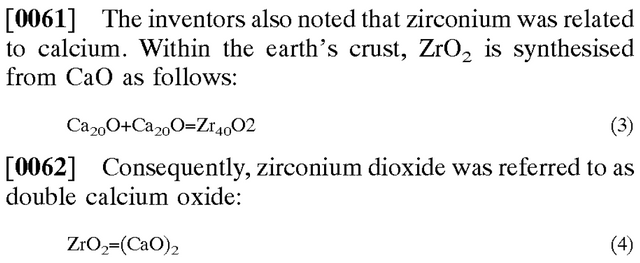
We have previously discussed the production of Zr in LION reactors.. It is quite clear that appearance of Zr is an important sign of LENR reactions.
Interestingly, Bolotov has a wide range of inventions, one such invention claimed to produce Silicon from Al and P. Looking at the nucleon exchange data, we can see the second and fifth most energetically favourable reactions are conversions of Al + P > Si + Si. Again, we see that the data supports the hard one empirical findings of a seasoned researcher. This may also be why P is often not observed in George Ohsawa reactions (in addition to its low boiling point) and one reason why it’s abundance in the crust is significantly below that of Si.
Moreover the patent says that high current density is required.
“A method for producing silicon comprising the production of high pressure elemental silicon from chemical elements of aluminium and phosphorus by the action of an electric current of a density greater than 1011 A / m^2”
So like many researchers, high electron density precipitates the effect. One such researcher, V. Krivitsky, proposes pulses of 7-10kA at 1000V with a frequency of 450kHz. a claim that has similarities to both Adamenko and Ralkar.
What then is ‘New Fire’ Fuel?
The implications of this work is that the New Fire, ‘LENR fuel’ has to have the active agent + elemental feedstock rather than just the elements that made the active agent (which may include some of those in the elemental feedstock). No active agent, no reactions.
Piantelli told us, you can make the ‘fuel' externally to the reactor or in the reactor and did both. This expressly implies that the elements themselves are insufficient.
me356, Suhas Ralkar, Holmlid and likely Rossi make it externally - it is the natural thing to do once it is understood at least on a cause and effect basis. From a commercial point of view, it also makes sense to not have the sold reactor able to produce the active agent. Moreover, you would engineer the sold reactor to cause the rapid degradation of the active agent if the sold reactor is tampered with. In this authors view, simple contact with water or moist air would be adequate.
Hutchison guided the nucleated active agent to the work area and grew and manipulated them there. Egely, Adamenko and others make the active agent in the reaction zone and then stimulate it at same time. Shoulders did both - you know this because he says he can store in metals indefinitely until intentionally put to work.
In the case of ECCO, more PbO could be added to the active agent containing seed ‘fuel’ as feedstock to enable longer duration reactions.
Targeting valuable metals
We have already started to discuss the production of Gold, so lets look at another valuable metal. At the time of writing, the value of Ir is over $43300/kg. By looking at the atomic volume chart and taking the view that the process is an implosive one, we know that we will need an element above the mass of Ir that has as high atomic volume as possible and one that is right at the other end of the periodic table, preferably, again with high atomic volume. The most favourable reactions will be those that can lead to the lowest atomic volume of the solid/liquid products whilst maintaining stability, that these will yield the most energy output may mean that, under the right circumstances, the overall net energy balance may be positive.
The obvious heavy (alchemical) metals for this purpose are
| Metal | $/kg at time of writing | Melting point | Toxicity | Reactions |
|---|---|---|---|---|
| Bi | 10-25 | 271.4 °C | Low | Element1 + Bi > Element3 + Ir |
| Pb | 2.58 | 327.5 °C | High | Element1 + Pb > Element3 + Ir |
Rhodium is even more valuable, at the time of this writing it is nearly $72000/kg So perhaps voltage biased, high current/voltage, high frequency discharges through molten lead chloride might yield valuable precipitations of Rhodium and evolution of Xenon gas. This is not a reaction for the average home-lab however. The interesting point here is that the noble gas Xe produced has a high atomic volume, something to consider.
Another option might be discharges through Zn and Pb, since they have similar low melting points, and the products, Rh and Ho have very high melting points.
Conclusion
This author has already written about some of the physical observations one can look for both during an experiment and after that indicates presence of the active agent.
In the view of this author, feedstock choices depend on many factors, some of which, in no particular order are:
- electrical conductivity
- electronegativity
- melting point and miscibility of components
- strength of the active agent / driving intensity and resonance (relates to level of implosive action)
- the net atomic volume of solid/liquid products compared to feedstock which is related to energetic favourability of the product balance
By having an idea of the output elements desired one can use the data provided by Dr. Alexander Pakhomov at FusFis.org, to establish potential reagent / element / phase choices for a process to target an element.
Non-exhaustive overview of some ’New Fire’ embodiments
The active agent can be made, stored, grown, harvested, used and abused in a variety of ways to effect excess heat, light, electricity, particles, transmutation and more. For examples, as shown above, the active agent can be advantageously used with element combinations that lead to desirable energy or element production. Choice of isotopes to use as feedstocks with the active agent would depend on physical parameters such as pressure, temperature, corrosiveness, phase, electro-negativity etc.
Natural Lightning
Make and break in bolt
Make and sustain in persistent ball lightning
Organic Life
Synthesises / captures and uses very small active agent
Mexican Alchemists
Harvested from environment and deployed
Tesla
Harvested from dry Utah environment and made active agent.
Henry Moray
Harvested from dry Utah environment and grew active agent ( acts like Dyson Air Multiplier description/patent )
Boris Bolotov
Made and destroyed active agent in an instant
Joseph Papp
Made active agent externally for first patent and internally to reactor for later patent, grew and harvested.
George Ohsawa
Made and destroyed active agent in an instant
John Hutchison
Guided nucleated active agents to zone where they were grown and manipulated. Typical transmutation was Al + Al > Fe
Kenneth Shoulders
Made, grew, stored and deployed in apparatus using say Hg and Kr
Alexander Chernetski
Made, grew and destroyed in apparatus with some ancillary effects of destruction observed
Pons and Fleischmann
Made, grew and triggered, with one major example of extreme.
Francesco Piantelli
Made, grew and harvested
Canon Patent
Made and then deployed active agent in cell
German Patent
Made and then deployed active agent in cell with D and Xe, both optimal in their own right for construction, leading to D + D fusion since D + Xe is less energetically favourable There is 31 possible D + Xe nucleon exchange reactions, but only 2 are more energetically favourable than D + D fusion and each DD fusion halves the distortion in the physical vacuum, making it highly desirable in an implosion basis.
Stanislav Adamenko
Made and destroyed active agent in an instant, saw wide range of ancillary effects of destruction.
Norris Peery
Made, grew and over excited to destruction in reactor.
Andrea Rossi
Made active agent in cell, likely first with the good old alchemical choice of K for lower temperature activation, then later Li for higher temperature operation and better yield, in combination with Al, which has a both nucleon exchange and fusion reactions to Fe that can then progress to Ni and Cu
Francesco Celani
Made, grew and sustained in wires
George Egely
Made, grew and over excited to destruction in reactor.
Leif Holmlid
Made and fed active agent and observed breakup.
Suhas Ralkar
Made, Grew and stored active agent in metal fuel externally. Cyclically, grown, harvested and destroyed in reactor
Anatolij Vachaev
Similar to Bolotov’s 1956 work, made and destroyed active agent in an instant
Clean Planet/Mizuno
Similar to Canon patent, but simplification. Made, grew and over excited to destruction in reactor
LION reactor 1/2
Strange radiation and other tracks similar to Shoulders observations + transmutation of materials, including to Zr observed.
Nucleated active agent in core. Grown over days in reactor materials.
We thank all those generous donors out there that make this work possible
For those interested in an open working New Fire reactor technology becoming available, please consider a PayPal donation here or via our MFMP Donation page where your name will be listed in the record of donors.
The project looses 4.5% on Paypal donations, so for those that can do a direct bank transfer, donations of any size can be made direct to Quantum Heat C.I.C.s (the organisation that runs the MFMP) bank account here, thus saving charges:
BANK: HSBC
Branch Address: 153 North Street Brighton, East Sussex, BN1 1SW
Account Name: Quantum Heat C.I.C
Sort Code: 40-14-03
Acc No.: 12631571
IBAN: GB48MIDL40140312631571
SWIFTBIC: MIDLGB22Or bitcoin: 1JesTRUXU8jHb1haa1MoF2NvrU8gt5msCr
If you would like to help the volunteer researcher that produced this blog article and conducted the analysis work >behind it, you can donate directly here.
Alternatively there is a US 501.c3 that also supports the goals of the MFMP, you can request information on how to contribute by that route by writing an email to m.fleischmann.memorial@gmail.com
Answer:
Good find Jouni and yes - very relevant.
This is Excellent verification of both LeClaire / Nanospire (who also often used laser pulses for cavitation), and Suhas Ralkar fuel processing. Both have cavitation, though I believe that Nanospire's / Ralkar's approach of having the bubble collapse asymmetrically against a ridged lattice, resulting in the bubble forming a 'spire' is more energetic and active due to induce helicity not present in symmetric collapse.
As I have said in previous presentations, I believe that the accelerated protons are those that are ejected from, in Adamenkos words, the "electron-nucleon macro-cluster" as heavier elements are formed which need to loose protons to ensure stability.
IMPO, they will find that they have synthesised elements.
However, the melting point of Pb is very low. When the temperature is high, Pb melts and the fuel powder sticks together.
Pb should be a substance produced by the LNER reaction. I think Pb is not an active substance.
The presentation goes to great lengths to show evidence that Pb is a product of the active agent.
The active agent, when driven at a certain level and presented with say PbS or PbO or Pb and C may yield other elements and products.
No active agent and it does not matter what else is in the cell.
Great Article, thanks to all
A definition of atomic volume
In a previous blog you can see I calculated the atomic volume and it matched the Russian encyclopedia (attached copy of chart)
What I actually want to do, is work with Stoyan Sarg this summer and produce a "Nucleus distortion of the physical vacuum chart" for all elements - and ideally all stable isotopes - This would, IMPO, be a much better metric than the old soviet atomic volume chart - this kind of fails a little on noble gasses etc.
I think people need to spend a little time thinking about WHY over 33 years, Kenneth shoulders did the following on naming what he considered the active agent, especially in context with all the things I have been sharing since September 2017.
Latin for "Strong Electron" was his first name.
Charge Cluster ( Recognising that it is not just electrons, but also entrained positive ions of any element)
Exotic Vacuum Objects
Think long and hard about WHY he settled on the last name... What is he trying to tell those that follow.
Yes there is an intermediate state. It is confined. On the term "Crystalise" it is clear you have been following the O Day hints and media - more on this in coming presentations, things will become increasingly obvious. Yes to favourable isotope that balances both inputs and the level of 'drive'.
EVOs are massively harvested by planes naturally. In this last blog, I Mentioned how Ancient Mexican Alchemists, Moray, Tesla captured, grew and deployed them. You can listen to this Soundcloud where the interviewee reveals how planes need to be discharged after they land and how a device was developed to capture 'Muons', Cough, ah hem....
Recommended reading of the recent writings of Ed Lewis on LENR-Forum
Also, one of his references is very interesting... It is a 1996 paper from George Miley who is now an advisor on S.V.Adamenko's US venture, in it he reports:
It would be very interesting to do a study of this data with the FusFis.org data.
Alexander Parkhomov observes production of Bismuth, Lead and Mercury from reactors that produced mega joules of excess heat and 'strange radiation' in paper published 15 Feb 2018.
"They are electrically neutral, so they move fairly freely in the substance.
They are able to leave the zone where they occur, and, permeating the substance, cause transmutations in their path. They can go outside the reactor and, getting on a photographic film or other detector, cause in it the appearance of surprising tracks, absolutely not similar to tracks from nuclear particles."
"In addition, the analysis of the substance in the reactor shows the appearance of heavy elements (bismuth, lead, mercury, silver, lanthanides, etc.)"
This where none of these heavy elements were present before.
In other images shared by MFMP in the past of some of these reactors, he observed similar 'scalloped' features in glass as observed in LION quartz.
Prof. V. Etkin PhD posted in 2015 how L.U. Alvarez discovered Cold Nuclear Synthesis in 1957 and got Nobel prize for it in 1968.
In addition, subsequent Russian research in 1957 by I.S. Filimonenko using Palladium, produced 'warm nuclear fusion' which "during operation, emits some kind of radiation, which drastically reduces the half-life of radioactive isotopes. However, both neutron radiation and radioactive waste were absent."
This is the first known observation of LENR, SR and Nuclear Remediation in one package.
Tip off: Jason Cook
https://goo.gl/VunKK7